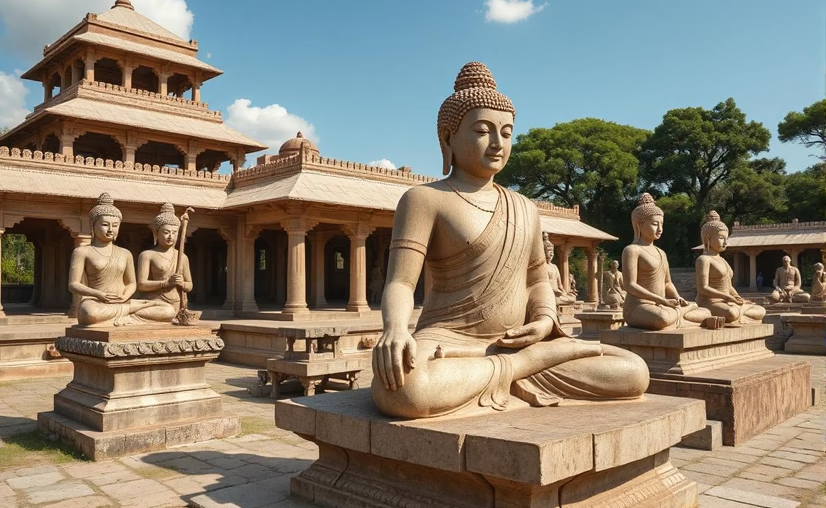Ashoka’s Contribution: The Royal Support for Buddhism

The Mauryan emperor Ashoka played a transformative role in Buddhism by providing it with royal support. Through his edicts and missions Ashoka propagated Buddhist teachings throughout Asia.
The historical impact of Ashoka transformed Buddhism from being a local belief system into a global tradition. Ashoka began his rule as a warrior king but turned to Buddhism following the horrors of warfare, and he then worked to create a compassionate and morally sound government during his reign. My work as an ancient Indian historian is enriched by Ashoka’s use of edicts, stupas, and missions to spread Buddhist teachings within society which has created a legacy that stands strong today.
Ashoka’s Transformation and Embrace of Buddhism
As the third emperor of the Maurya dynasty Ashoka governed a massive territory that covered present-day India, Pakistan and Afghanistan. The massive loss of life from the Kalinga War (c. 261 BCE), which claimed over 100,000 lives, plunged Ashoka into deep remorse. He embraced the dharma with Buddhist monks as his guides because they taught him to value non-violence and compassion. According to Romila Thapar, Ashoka’s transition to Buddhism as shown in his edicts marked a shift from territorial conquest to ruling through moral principles.
Key Changes Post-Conversion
- Non-Violence (Ahimsa): Banned animal sacrifices and promoted vegetarianism.
- Social Reforms: Ashoka constructed hospitals and schools which admitted people from all castes.
- Personal Practice: Meditated and supported the sangha (monastic community).
The Edicts: Spreading Buddhist Ethics
The inscriptions Ashoka left on pillars and rocks using the Prakrit language and Brahmi script rank among his most significant achievements. More than thirty principal edicts throughout India advocate for Buddhist ideals including tolerance and charitable behavior as well as religious respect. The British Museum showcases their impact on developing ethical governmental principles. Major Rock Edict 13 reveals Ashoka’s remorse for the Kalinga war and his pledge to uphold dharma.
Features of the Edicts
- Ethical Guidance: Encouraged compassion, truthfulness, and respect.
- Multilingual Access: The Greek and Aramaic translations of these texts enabled access for varied audiences.
- Public Display: Placed along trade routes for maximum visibility.
Discover additional information about Ancient Buddhist Legacy through our dedicated article.
Stupas and Viharas: Architectural Patronage
Under Ashoka’s reign many stupas and viharas were built to commemorate the Buddha while supporting monastic activities. Following expansion during his rule the Sanchi Stupa stands today as a UNESCO World Heritage Site. Archaeological studies show he constructed or renovated a total of 84,000 stupas. The Buddhist viharas established at Taxila played a key role in advancing education which helped solidify Buddhism’s structural foundation.
Impact of Architecture
- Pilgrimage Centers: Stupas like Sanchi drew devotees, spreading teachings.
- Monastic Growth: Monks resided in Viharas where they maintained religious manuscripts including the Pali Canon.
- Artistic Legacy: Carvings depicted Jataka Tales, teaching ethics.
Global Missions: Buddhism Beyond India
Ashoka’s key legacy remains his initiative to dispatch Buddhist missionaries who spread their faith across Asia and into the Mediterranean regions. Mahinda his son introduced Buddhism to Sri Lanka and it was there that the Pali Canon was eventually compiled. According to the Mahavamsa chronicle Buddhist missions extended to Greece, Egypt and Southeast Asia. Research published in the 2018 Journal of Buddhist Studies acknowledges Ashoka as the catalyst for Buddhism’s initial global expansion.
Missionary Reach
- Sri Lanka: Established Theravada Buddhism, thriving today.
- Central Asia: Silk Road cultures absorbed Greek artistic elements under Ashoka’s influence.
- Southeast Asia: Laid foundations for future Buddhist kingdoms.
Explore how Buddhism spread throughout history in our Journey of Buddhism article.
Why Ashoka’s Contribution Matters Today
Ashoka’s historical significance continues to teach current generations about moral leadership and peaceful religious coexistence. Modern governance systems look to Ashoka’s edicts for inspiration while his stupas continue to attract countless pilgrims. According to a 2022 article in Heritage Studies Ashoka’s historical sites drive cultural tourism while helping people worldwide understand Buddhist teachings.
Ways to Engage with Ashoka’s Legacy
- Visit Sites: Explore Sanchi or Ashoka’s pillars in Delhi.
- Study Edicts: Read translations at Ancient Buddhist Texts.
- Ethical Practice: Apply non-violence and compassion in daily life.
- Support Preservation: Advocate for UNESCO site conservation.
FAQ: Ashoka’s Contribution to Buddhism
- Q: How did Ashoka’s rule impact the spread of Buddhism?
- A: Under Ashoka’s rule Buddhism expanded across Asia because of his establishment of edicts and construction of stupas and viharas along with missions to propagate its teachings.
- Q: What are Ashoka’s edicts and their significance?
- A: The carved edicts promoted Buddhist ethics which led societies to practice compassion and tolerance while shaping ancient governance systems.
- Q: How did Ashoka’s patronage affect Buddhist architecture?
- A: Stupas such as Sanchi and viharas were constructed by him to establish pilgrimage sites which also functioned as learning centers vital for maintaining and disseminating Buddhist teachings.
- Q: Why does Ashoka hold a pivotal position in Buddhist history?
- A: Buddhism became a global tradition due to his royal endorsement which established its practices and ethical framework.
- Q: Which resources should I consult to understand Ashoka’s Buddhist legacy better?
- A: You can read translations of edicts at Ancient Buddhist Texts or explore UNESCO World Heritage sites such as Sanchi.
Conclusion: Ashoka’s Enduring Buddhist Legacy
Ashoka used royal backing and worldwide expansion to establish Buddhism as a symbol of wisdom and compassion. The principles he established continue to prompt modern individuals to pursue ethical lifestyles. Join the discussion about Ashoka’s influence by posting comments or subscribe for additional historical insights on Buddhism!